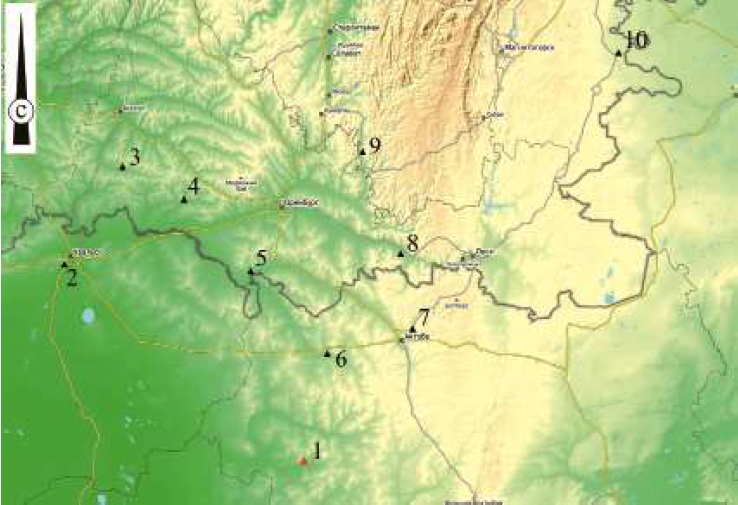STUDIES OF MEDIEVAL MAUSOLEUMS IN THE KOPTAM TERRAIN IN WESTERN KAZAKHSTAN
DOI:
https://doi.org/10.24852/2587-6112.2024.2.328.339Keywords:
archaeology, Western Kazakhstan, Golden Horde, brick mausoleum, burial riteAbstract
The purpose of the article is to publish materials from archaeological excavations of previously unknown medieval mausoleums in the Aktobe region of Western Kazakhstan. The mausoleums were explored near the village of Taskopa in the Koptam area. The fi rst mausoleum is square in plan, built of burned and mud bricks. There is a portal on the front side. External dimensions of the structure: length – 7.8 m, width – 6.9 m. Wall thickness is 1.3-1.5 m. Three burials were examined inside. A brick mastaba gravestone was built over each burial. Burial 1 is collective: two adults and a child. Burials 2 and 3 are individual. All the buried lie stretched out on their backs, with their heads to the west and a deviation to the north. There are no grave goods. The second mausoleum is small in size and heavily ruined. Length – 8.0 m, width – 7.0 m, wall thickness no more than 0.7 m. It contains the burial of an adult without goods. Features of architecture and funeral rites allow us to date these mausoleums to the 14th century. The canonicity of the architecture and funeral rites suggests that these mausoleums were built by the urban Muslim population, possibly by settlers from Khwarazm.
References
Adzhigaliev, S. 1983. In Izvestiia Akademii Nauk Kazakhskoi SSR. Seriia fi lologicheskaya (Bulletin of the Academy of Sciences of Kazakh SSR. Philological series) (2), 56–63 (in Russian).
Baipakov, K. M., Smagulov, E. A., Akhatov, G. A. 2002. Voprosy istorii i arkheologii Zapadnogo Kazakhstana (Issues of History and Archaeology of Western Kazakhstan) 1, 168–184 (in Russian).
Bisembaev A.A. 2003. Arkheologicheskie pamiatniki kochevnikov Zapadnogo Kazakhstana (VIII–XVIII vv.). (Archaeological monuments of the medieval nomads of Western Kazakhstan (8th-18th centuries). Uralsk (in Russian).
Bisembaev, A. A., Akhatov, G. A. 2016. In Bocharov, S. G., Sitdikov, A. G. (eds.). Dialog gorodskoi i stepnoi kul'tur na Evraziiskom prostranstve. Istoricheskaia geografi ia Zolotoi Ordy (Dialogue of the Urban and Steppe Cultures in the Eurasian Space. Historical Geography of the Golden Horde). Kazan; Yalta; Kishinev: “Stratum plus” Publ., 74–76 (in Russian).
Botalov, S. G., Malamud, G. Ya. 2001. In Fedorov, V. K. (ed.) Ufi mskiy arkheologicheskiy vestnik (Ufa Archaeological Bulletin) 3. Ufa: National Museum of the Bashkir Republic, 162–167 (in Russian).
Garustovich, G. N. 2012. In Mirgaleev, I. M. (ed.). Zolotoordynskaia tsivilizatsiia (The Golden Horde Civilization) 5. Kazan: “Foliant” Publ.; Institute of History named after Sh. Mardzhani, Tatarstan Academy of Sciences, 126–136 (in Russian).
Garustovich, G. N. 2013. In Vestnik Vostochnoy ekonomiko-yuridicheskoy gumanitarnoy akademii (Bulletin of the Eastern Economics and Law Humanities Academy) 63 (1), 108–113 (in Russian).
Garustovich, G. N. 2014. In Zolotoordynskoe obozrenie (Golden Horde Review) (2), 95–119 (in Russian).
Chibilev, A. A.1987. Reka Ural (The Ural River). Leningrad: “Gidro meteoizdat” Publ. (in Russian).

Downloads
Published
How to Cite
Issue
Section
License
Copyright (c) 2024 Bissembaev Arman A., Khavansky Aleksei I., Zhanuzak Ramazan Zh.

This work is licensed under a Creative Commons Attribution-NonCommercial 4.0 International License.







